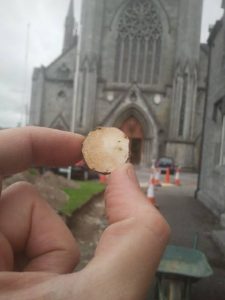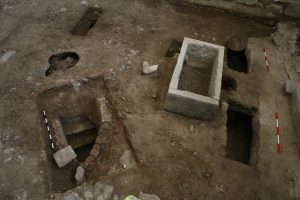Money box from Kilkenny Archaeology’s excavations at Highhays, Kilkenny
July 5, 2019
A fourteenth century money-box from the Highhays pottery production centre, Kilkenny (photo: Kilkenny Archaeology/John Sunderland). The money-box was found in 2006 amongst the 5000 pottery sherds recovered during excavation of a kiln, workshops and clay processing pits by the late Emma Devine and Cóilín Ó Drisceoil at Highhays, Dublin Road, prior to the construction of the MacDonagh Junction shopping centre. Money boxes such as these were used to store coins and they have a small slot which was used to deposit the coins. In this case the money-box has been broken along the slot, indicating it was deliberately broken to remove the coins. Perhaps, therefore, it belonged originally to the Highhays potter?!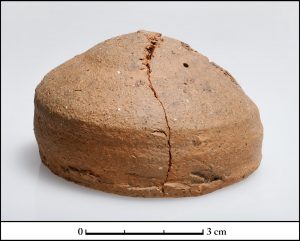
Gaming piece Kilkenny Archaeology excavations St Mary’s Cathedral
July 5, 2019
A gaming piece modelled from a piece of late 18th century creamware pottery. This was found in excavations of a demolished tenement house that formerly stood on James’s Street, now beside St Mary’s cathedral. The tenements were pulled down for the cathedral in the 1840s.
Kilkenny Archaeology excavations St Mary’s church, Kilkenny
July 5, 2019
Entrances to burial vaults in the south transept of St Mary’s Church, Kilkenny, as revealed in 2016 excavations. In the centre is the altar-tomb of Walter Archer (d. 1575), which was buried beneath an eighteenth century floor.
Freestone Hill
July 5, 2019
Early Bronze Age burial mound at Freestone Hill Hillfort, Kilkenny. In the Early Bronze Age, c. 2000 BC, a large burial cairn was built to contain human burials on the summit of Freestone Hill. The cairn was excavated by Gerhard Bersu in 1946 and was found to contain three inhumation burials, along with thirteen cremations. Two of the cremations were associated with Early Bronze Age Food Vessel pottery. None of the inhumations had associated grave-goods and they appear (though this is not certain from the excavation report) to have been secondary insertions into the burial cairn. Today, you can still see remnants of the cairn on the top of Freestone Hill.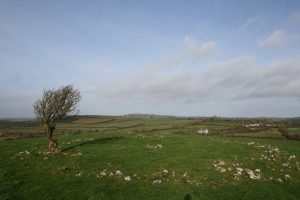
Grim discoveries at Gallows Hill
July 5, 2019
In September 1969 county council workers were quarrying from a sandpit beside the scout den on the Bennetsbridge road when suddenly ‘thousands’ of human bones fell out from the side of the cutting. These were packed up in bags and some ended up in the National Museum of Ireland. One of the bodies was examined and found to be an adult male of unusually strong build, over six feet in height and about 30 years old. Since the name of the townland is Gallows Hill, and a large tree in the area also bears this name, some of the bones may have been the remains of unfortunates that were executed here. However many of the bones were mixed up (‘disarticulated’) and could have suffered a grisly end in a gibbet, a gallows-type structure from which dead bodies were hung on public display to deter criminals. In the medieval period execution sites, such as this, were often placed on the outskirts of towns.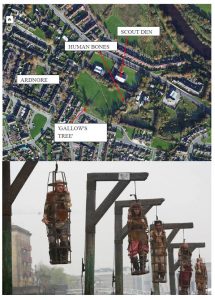
Prehistoric axe at Talbot’s Tower
July 5, 2019
Around six thousand years ago small clearings were made by the earliest farming communities in the forested landscape of what is now Kilkenny City. One of the most important tools used by these Neolithic communities was the polished stone axe. A fragment of one such axe was found by James Cahill in the old ground level below the Town Wall at Talbot’s tower, New Street, during Kilkenny Archaeology’s excavations in 2010. What is really interesting about this particular stone axe is the stone that it is made from, porphyry. The only source of porphyry in Ireland is on Lambay island, off the coast of Dublin, 80 miles to the east of Kilkenny. Excavations by Gabriel Cooney on Lambay uncovered the remains of the quarry where the Talbot’s tower axe was almost certainly made. The excavation at Talbot’s Tower was funded by Kilkenny County Council and the Irish Walled Towns Network.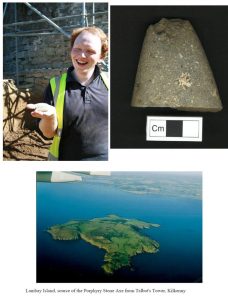
River Nore Heritage Audit 2009
September 4, 2009
Action No.8 of the Draft County Kilkenny Heritage Plan 2007-2011 is to undertake a community based project on all aspects of the River Nore’s Heritage. Kilkenny Archaeology have been comissioned by Kilkenny County Council to carry out a heritage audit (built, natural and cultural) of the northern section of the river in Kilkenny, from Ballynaslee on the Laois border in the north to Ossory Bridge (Maudlinsland and Archersgrove townlands) in the south. The key purpose of the project is to raise awareness amongst the local community and wider society of the Nore’s rich cultural and natural heritage. In addition the results of the project will inform future planning, management and infrastructure delivery along the river corridor. As the project progresses updates will be given on this website.
New Website Launches
April 17, 2009
We’ve just launched our new website, KilkennyArchaeology.ie where you can keep up to date with projects we’re working on. You can also visit the Kilkenny Archaeological Project here.

